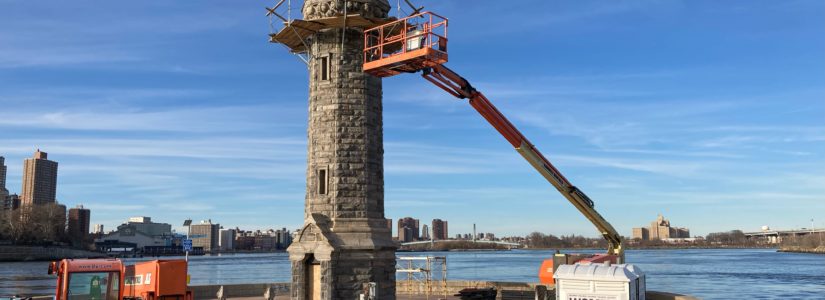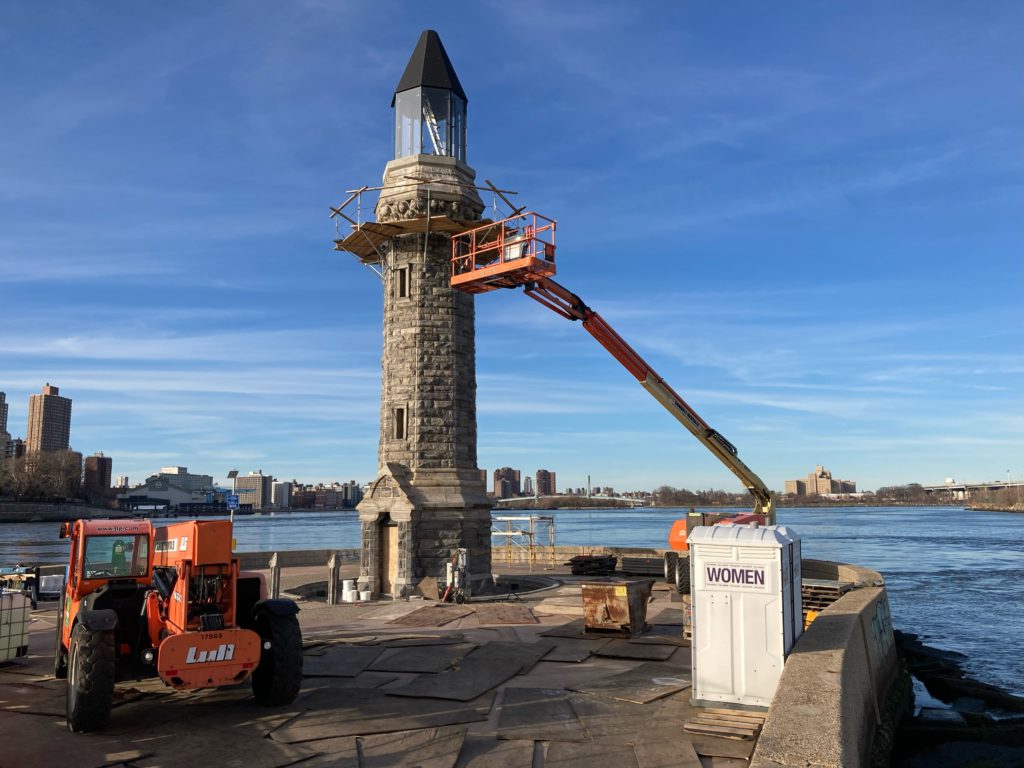
Layers Five Decades Deep
Historic Preservation on Roosevelt Island

By John C. Harris, 2022 Jeffe Fellow
Sometimes, to get to a preservation story, one must dig through mounds of history. Roosevelt Island is a case in point. It has a “layered” history, as Judith Berdy, president of the Roosevelt Island Historical Society, attested in my recent conversation with her.
Island History
The small cigar-shaped strip of land, roughly one-eighth of a mile wide and one and a half miles long, was originally called “Minnehanonck” by the indigenous Lenape community. In 1637, Dutch colonial settlers purchased the land and expelled the Lenape. Soon after, the English defeated the Dutch for control of the region, and in 1664, the island was purchased by the wealthy Manning family. The Mannings eventually bequeathed the property to a son-in-law, Robert Blackwell; the land (“Blackwell’s Island”) remained in the Blackwell family for nearly 150 years until it was sold to the City of New York in 1828.
Roosevelt Island’s history remains entwined with a significant number of governmental entities. Throughout the 19th century, the City operated penitentiaries, an asylum, and several hospitals on Blackwell’s Island. It was renamed Welfare Island in 1921 in reference to the City Hospital operating there. The transformation of the island into a residential neighborhood began in 1969 when the New York State Urban Development Corporation (UDC), under the leadership of Edward J. Logue, signed a 99-year lease on the land with the intent to develop the property into a residential community. As part of the project, in 1974, the island was renamed in honor of President Franklin D. Roosevelt. A year later, in April 1975, the new housing developments on the island received their first residents. With this most recent repurposing of Roosevelt Island, the story of modern preservation efforts begins.
Preservation Narratives
Like image of a “layered” history provided by Berdy above, the story of historic preservation on the island is similarly intricate. It is the story of state organizations, community groups, and inspired individuals all working together—and sometimes in competition with one another—to preserve the history and the built fabric of Roosevelt Island.
The Roosevelt Island Urban Development Corporation (RIDC), a subsidiary of UDC, began its transformation of the island with a somewhat preservationist slant. That lucky break resulted in an early victory for preservation. On November 25th 1975, the relatively new Landmarks Preservation Commission (LPC) evaluated six buildings which embody key characteristics of the island’s varied cultural identities: the Blackwell House (1796), the Octagon (1841), the Smallpox Hospital (1856), the Lighthouse (1872), the Chapel of the Good Shepherd (1888), and the Strecker Memorial Laboratory (1892). In every case three unnamed representatives spoke in favor of designation while representatives from RIDC also supported landmark designation. Each of the buildings achieved individual designation on March 23, 1976. Today all of these structures are included in the New York State Register of Historic Places and National Register of Historic Places. While any one of these buildings might be the icon that comes to mind when one considers preservation on Roosevelt Island, rest assured there is more to the story.
Advocacy and Leadership
In 1977, immediately after the initial push to preserve the architectural heritage of the island, the Roosevelt Island Historical Society (RIHS) formed. Its founding members were Rev. Oliver Chapin, Dorothy Pavane, Carole Kennedy, and Audrey Braver. Today RIHS seeks “to recover, maintain and disseminate the record of Roosevelt Island’s heritage from Colonial times to the present.” The group accomplishes this mission by preserving the historical record and cultural landscape of the island, conducting educational initiatives in its visitor center, and providing self-guided historical tours.
There are always leaders within preservation movements who are uniquely dedicated to maintaining a community’s place within the historical record. On Roosevelt Island, one must review the work of the late Rev. Oliver Chapin. He may very well be considered the first preservationist to reside full time on Roosevelt Island. Chapin moved to what was then called Welfare Island in 1964 as an Episcopalian minister and hospital chaplain at Coler Hospital on the island. During his 35 years on the island until his death in 1999, he took on the role of community historian. Chapin amassed an archive of photos, records, and objects dedicated to the history of the place. From that archive he conducted research that formed the basis of his walking tours. During these tours he conveyed the history of Roosevelt Island’s most important buildings, the lives they contained, and the land upon which they were built. Throughout his work, Chapin was keen on meeting community members where they were. He took advantage of community events, such as fairs and commemorative anniversary events, to present slide shows and exhibitions of the island’s history. In addition to these more public ventures, Chapin completed eight chapters of a book about the history of Roosevelt Island. Unfortunately, the book was never published. However, the manuscript and contents of Chapin’s archive
remain in the collection of Roosevelt Island Historical Society.
In the absence of Chapin, Judith Berdy now carries the torch of chief preservationist on Roosevelt Island. Her fascination with the island began in the 1960s when she worked in Goldwater Hospital. Soon after she moved to the community in 1977, Berdy attended one of Chapin’s walking tours. This experience inspired her to join the newlyformed RIHS.
Despite her lack of formal training in historic preservation, Berdy became a committed steward of the island’s history, and in 1999 she became the president of RIHS. Since then, her philosophy of promoting the island’s captivating past to anyone who will listen has helped her expand RIHS to more than 70 members, in addition to a core team of about a dozen. Her success is founded in her adaptability as a self-described “jack of all trades.” Despite the organization’s well-formulated mission statement, she acknowledges that preservation often takes whatever shape that available resources can provide. In her words, preservation on Roosevelt Island occurs with “whatever flows, whatever comes along…it’s not an Excel spreadsheet. We go with what we have to do.”
Recent Successes
This approach has informed the success of several initiatives during Berdy’s presidency. In 2002, the group created the Roosevelt Island Historical Society Walking Tour. The tour, along with its signage and website, was revitalized in 2014 as a collaborative project with Columbia University’s School of Architecture, Planning & Preservation.
The revitalization effort was overseen in part by Archive Project board member Liz McEnaney. In 2003, Berdy and RIHS used historic photographs to publish Roosevelt Island as part of Arcadia Publishing’s “Images of America” series, which reveal local and regional histories through historic images. They contributed to the “Images of America” series once again five years later collaborating with the Greater Astoria Historical Society to publish The Queensboro Bridge. In 2006, RIHS’s archive informed the restoration of the landmarked Octagon and its repurposing into luxury housing. Preservation efforts by RIHS repeatedly raised awareness of the island’s past, ensured the longevity of its historic fabric, and simultaneously accommodated newcomers to contribute to the future of the community.
In addition to these notable preservation highlights, Berdy is most proud of her involvement in RIHS’s acquisition of the original terra cotta trolley kiosk which, from 1909 until 1957, provided access to the trolley that transported Roosevelt Island commuters to Manhattan and back by way of the Queensboro Bridge. After the opening of the Roosevelt Island Bridge between Queens and Roosevelt Island, which eliminated the need for the trolley, the Beaux Arts-style kiosk, complete with Guastavino tiled ceiling, was repurposed as the entrance of the Brooklyn Children’s Museum (BCM). RIHS’s project to return the kiosk to its home began in 2003 when BCM announced a renovation project that would remove the structure. The acquisition played out as a joint effort between RIHS and BCM, as well as the State of New York (which leases Roosevelt Island land from the City of New York, and, in turn, leased the property where the kiosk was to be located to RIHS).
In 2006, after a three-year long bureaucratic process, the trolley kiosk was placed on a truck and transported to the island. In July 2007, it opened as the Visitor Center Kiosk, operated by RIHS. It was then shut down for a three-year long restoration process. Following the reopening of the kiosk in 2011, RIHS and Judith Berdy were presented with the Friends of the Upper East Side Historic District’s Restoration Award for their work on the kiosk.
Partnerships and Challenges
It is evident that historic preservation on Roosevelt Island—like all preservation work—depends on the cultivation of working relationships within the community. That fact was clear during the restoration of Chapel of the Good Shepherd by Giorgio Cavaglieri in 1975 after recommendations made by LPC during an evaluation process. New partnerships were formed during the 13-year odyssey to acquire $2.9 million for the restoration of the Blackwell House in 2020. Funding ultimately came from Council Member Ben Kallos, the City, and RIDC successor Roosevelt Island Operating Corporation (RIOC). Dynamic collaboration continues to ensure the longevity of the historic structures today through the campaigns to preserve Smallpox Hospital spearheaded by Friends of Roosevelt Island Landmarks and Friends of the Ruin. A special relationship exists among Roosevelt Island preservationists and architect Thomas Fennimen, who since his initial work on the kiosk project, has ensured that preservation flourishes on the island. He is currently replacing the top lamp and restoring the top point of the 50-foot-tall lighthouse. The 150-year-old structure was originally built to guide vessels away from the island and around the granite boulders submerged nearby in the East River. Today it stands as the centerpiece of Lighthouse Park at the island’s northernmost point and through the efforts of dedicated preservationists, it will serve to keep the residents aware of—and connected to—the history of their community.
Despite this track record of success, historic preservation on Roosevelt Island is not without its own unique challenges. The most recent is the COVID-19 pandemic. For the first half of 2020, there were no visitor center operations. Over the duration of the pandemic, RIHS did not produce in-person programs. Both setbacks resulted in less money generated by the group. However, the RIHS remained resilient. Rising to the challenge, the society developed creative fundraising techniques like the “penny collection” at the local market, which collected loose change (and dollars) amounting to nearly $1,200 within only a few weeks. Likewise, RIHS adjusted its programming and maintained its collaborative nature by teaming up with the local library to generate virtual programming that explores the history of the island. Furthermore, this programming gets the public involved with the curation of history by improving Roosevelt Island Wikipedia pages. Additional preservation issues arise from RIOC’s recent maneuvers. For example, RIOC’s institutional archives—once stored in an unused indoor handball court of the community gymnasium—were removed from the island and transferred to the New York State Archives in Albany. While the records might be safer in Albany, their removal reduces community access. Additionally, Berdy asserts that RIOC’s virtual meetings of late seem to be structured so as to prevent any meaningful participation from the community.
Despite these recent setbacks, preservation on Roosevelt Island is thriving. The legacy of historic preservation on the island, in context of the larger story of preservation in New York, provides nearly a half century of collaborative and innovative examples of how to generate a movement that protects a community’s history in the built environment.